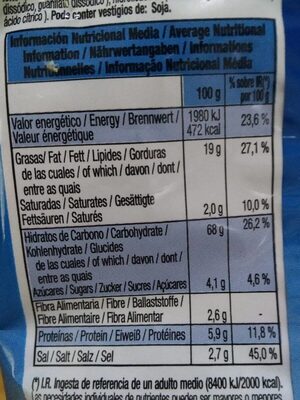Chaskis - Facundo - 100g
Aquesta pàgina del producte no està completa. Podeu ajudar a completar-la editant-la i afegint-hi més dades a partir de les fotos ja disponibles, o fent-ne més amb l'aplicació de androide o iPhone / iPad. Gràcies!
×
Codi de barres: 8413671022219 (EAN / EAN-13)
Quantitat: 100g
Marques: Facundo
Categories: Snacks
Etiquetes, certificacions, premis: Lliure de gluten, Lliure d'oli de palma
Enllaç a la pàgina del producte en el lloc oficial del productor: http://facundo.es/es/productos-aperitivo...
Matching with your preferences
Entorn
Empaquetament
Transport
Report a problem
Fonts de dades
Producte afegit per peconatss
Última modificació de la pàgina del producte per foodless.
La pàgina del producte, també editada per deliv, kiliweb, musarana, openfoodfacts-contributors, redspider, roboto-app, yuka.UnFrQkw2MGUvT3NLeXYwUS96Nkszdnh0NGErM1FHTG9LZFFTSWc9PQ, yuka.V0x3akc0RXppNmtHa3ZBUjVFenB5c3hWMVlmeVFXcXVJZUVWSVE9PQ, yuka.ZXYwOU5Jczh1UE1XeE1FbDBpL0g1b2xVMllPV2VqT0djY1VQSVE9PQ, yuka.sY2b0xO6T85zoF3NwEKvlnFlboTRjgOeOC7jn2-z94uWKKTMeN9q8rn_Yqs.











